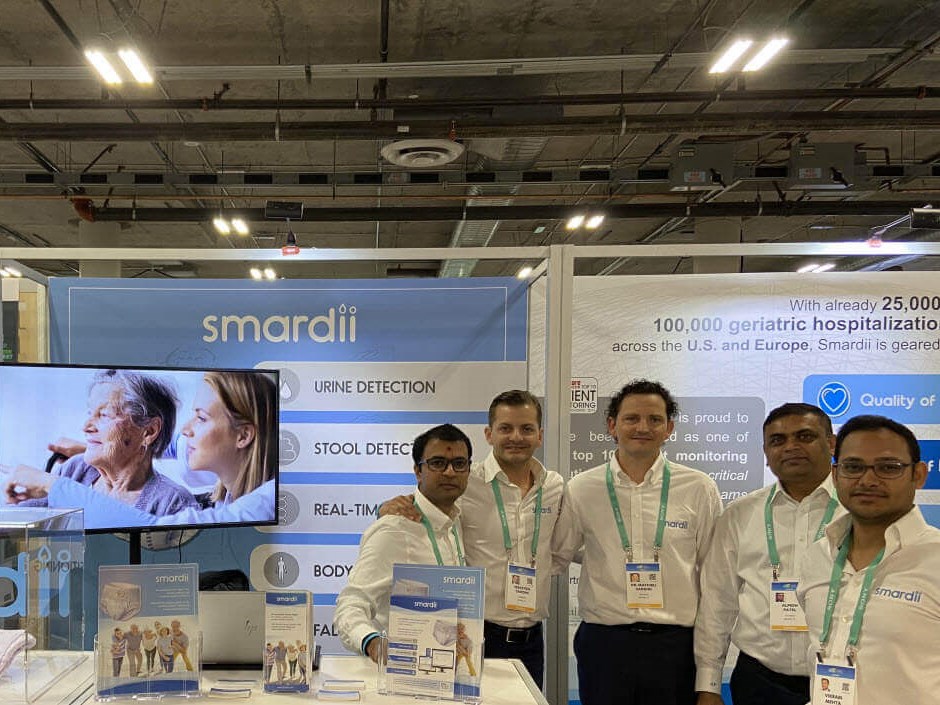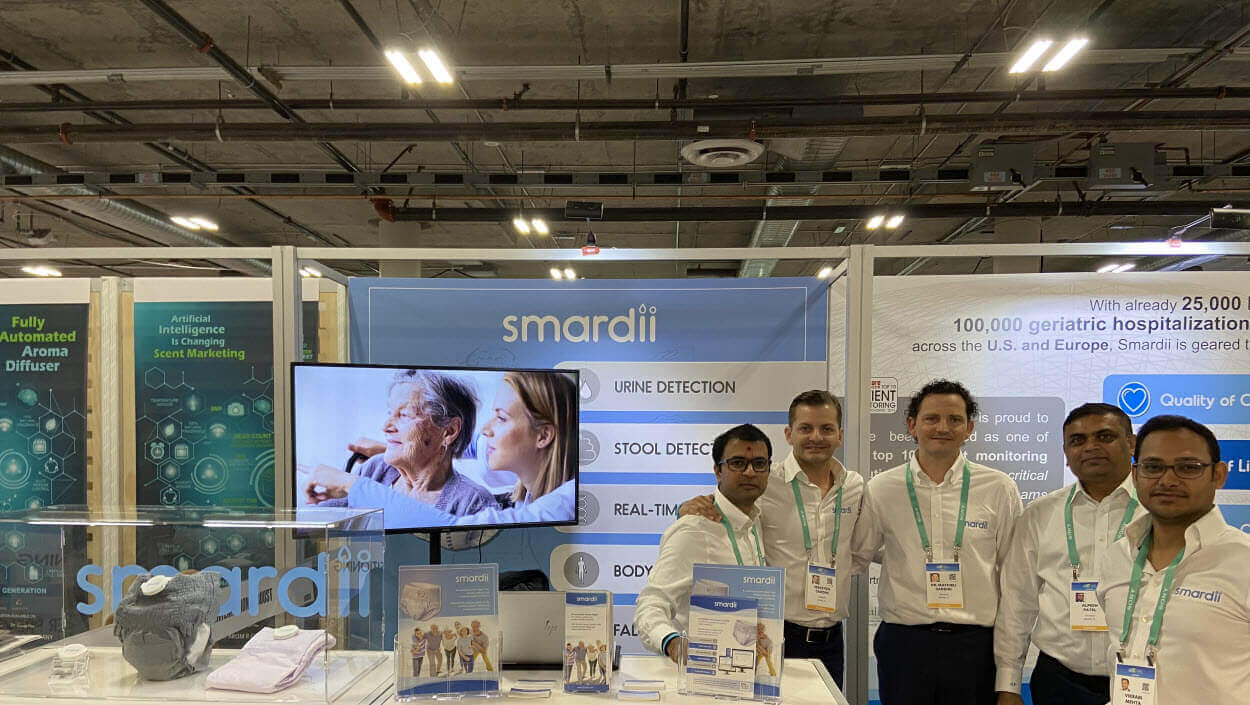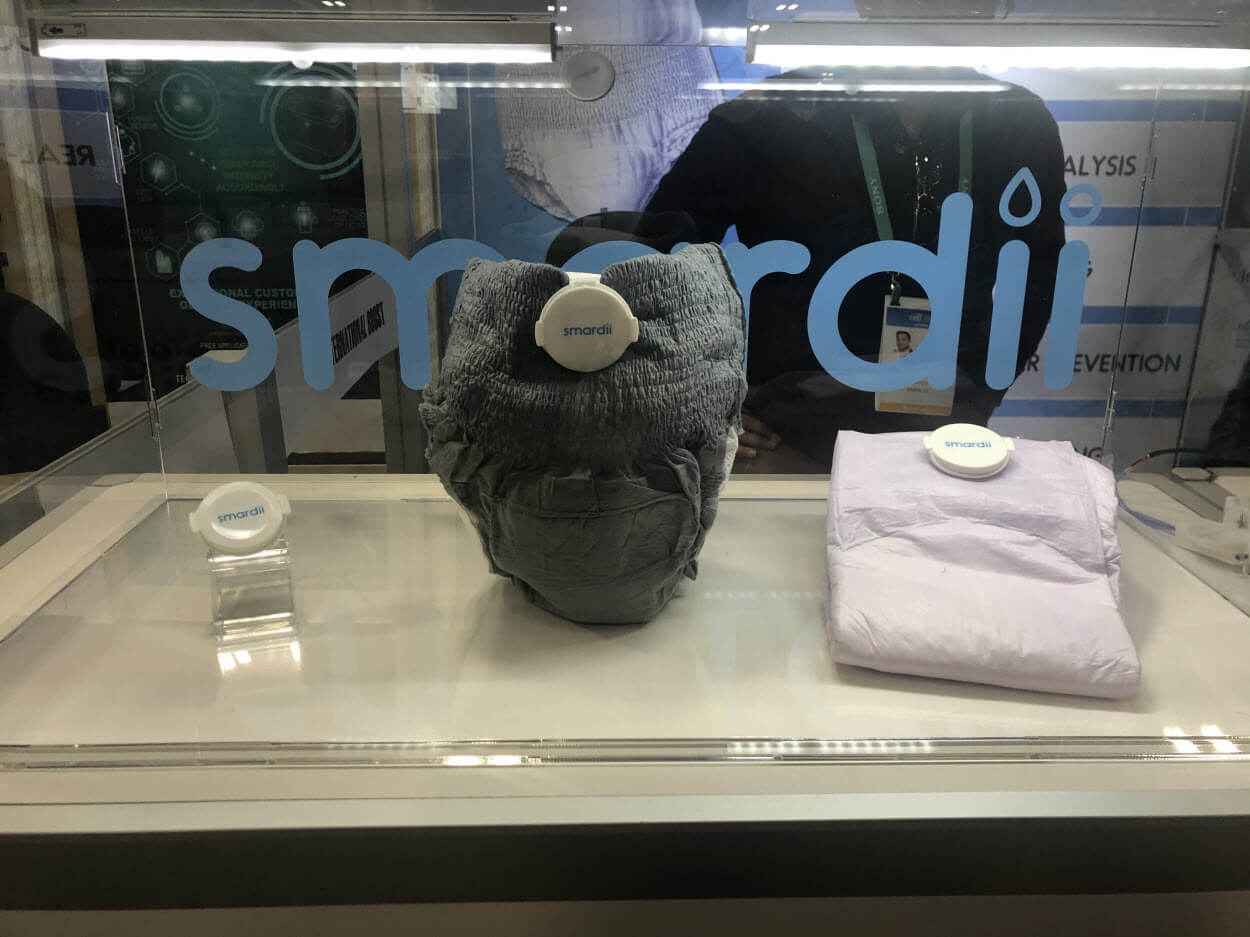
A big hit at the recent CES show, the smart diaper solution is designed to improve people’s quality of life, starting with elderly care. Smardii’s co-founders Sebastien Gaddini and Vikram Mehta explain more to Fiona Haran.
Within the last few years, a handful of smart diaper products have emerged, with the earliest ones designed to simply detect wetness. But the industry realised that to make a real difference to consumers’ lives, the diapers would have to offer much more. And so, scientists and engineers are exploring ways in which these products could monitor and help solve underlying health problems.
One particular product that is showing real promise in this field is the Smardii diaper – a ‘medical screening tool’ designed to ‘revolutionise’ health monitoring. Two of the founders behind the product – Sebastien Gaddini, in charge of Corporate Strategy, and Vikram Mehta, head of Global Operations, talked me through the product as well as the factors that led to its development. They had just returned from their very first exhibit at CES, the Las Vegas consumer technologies showcase, where the reception to the product was said to be ‘unbelievable’.
“We had some expectations going over there … we were thinking that we’d be at our booth and people would stop by once in a while, but in fact, we didn’t have any downtime; it was absolutely insane,” says Gaddini.
How it works
Initially targeted at the adult incontinence market, the Smardii diaper comprises two parts: disposable sensors embedded into a brief layer, and a reusable, rechargeable, waterproof disk called the Puck. In a brief, it can detect urine, stool, temperature, body positioning, and run a real-time analysis. While this is happening, critical health data is being monitored by nurses on the intuitive Smardii Nursing Station – a platform that uses proprietary algorithms allowing caregivers to remotely monitor the health conditions and wellbeing of their patients and residents, and flag potential issues before they lead to something more serious.
Providing some background on the product, Mehta says: “It came about from personal pain points we experienced of loved ones who were receiving care at home or whom we were looking for a place to receive around-the-clock care. So, when we came to build [the product], we thought we could develop features that do more than let the nurses know that it’s just wet. We built in a lot of things that we learned when starting to talk to nursing homes and hospitals and caregivers and home help agencies.”
He continues: “What’s important is that when a diaper does a good job it will wick away all the moisture, but you also need to know when [the patient] has also had a bowel movement because that can lead to other issues. So, those are the two core features we knew we’d have to have. And in the later generation of our products we’re going to have urine analysis, so you’ll be able to look for certain biomarkers in urine. You may not be aware but there are 3,000 compounds in urine that you can look for. Some are very important, especially when you combine them with other factors. Some will include glucose in urine, nitrates, blood, pH, things like that. And some patients may not be able to provide a urine sample and need to be catheterised, which is very uncomfortable and costly.”
Another important consideration for caregivers was the tracking of patients, says Mehta, ‘in case they’re going somewhere they’re not supposed to be, or if they’re at risk of fall’.
“If we combine all these features together, now you’re providing total care and preventative care. And if you consider urine and stool detection in the US by law, what has to happen is that every couple of hours in the nursing facility, patients have to be checked to make sure they don’t have a soiled environment. We therefore took into account a range of aspects – physical and mental,” Mehta explains.
Support network
The huge response Smardii has received from the care community is largely a result of the approach the company took right from the very beginning.
“We had partnerships with a number of nursing homes and hospitals across Europe and the US. We’ve been speaking with them for the last four years, understanding their process, how they work, how they spend their money, what issues and challenges they’re facing. And this is how we build the case studies with them,” says Gaddini.
What has also held the company in good stead is the interdisciplinary nature of its team, which includes a chief medical officer and an engineer. Gaddini, meanwhile, is a private equity M&A lawyer and Mehta has 20 years of Wall Street experience.
“For Vikram and myself, our background is more in private equity. We knew together that we couldn’t build the design – we’re not technicians – so we actually put together a team of technicians to build the product while the two of us would be building the company and researching our market, strategy and competitors like we do in the finance world. We run our start-up as if it were a multinational,” says Gaddini.
And for Smardii, the vision has always been long-term. “When we came up with the idea four years ago, we were not the only company looking into [smart diapers], but we were certainly among the first ones, and we knew it would take time to develop all of that technology. So, four years ago, we said: ‘What will really make an impact and help patients’ families and doctors?’ And we anticipated that there would be a lot of companies out there trying to detect moisture in a diaper, and I guess we were right because you see a lot now. The problem is that it takes so long to develop the technology – if your vision is short term, by the time you are on the market you’re already obsolete. So, we worked on many features because we knew that moisture detection alone is not enough. Doctors at CES said moisture detection was a good beginning, ‘but the game changer is what [Smardii] is offering’. We thought of that four years ago so that when our product is on the shelf (this year), we are not already obsolete,” Gaddini says.
Adding value
You could say that Smardii demonstrates the very essence of what smart devices must offer in order to thrive. Sure, it’s all well and good tracking vital signs or other personal data, but as many industry experts have alluded to, consumers need to be able to make sense of that data in order to improve the quality of their lives.
“I remember four or five years ago, I was in New York going to medical industry events, and there were a lot of panels and conversations about smart sensors,” Gaddini begins. “And there was one very well-known investor who said that AI and sensors to solve demographic challenges are the future. He gave the example of an activity tracker bracelet that was really big at the time. He said, ‘It’s cool, everyone has one, but at some point, you’re going to get tired of it because it’s giving you data but what are you doing to do with that data? What’s the point? You know you’ve taken 10,000 steps, okay cool … then what?’ He said that you need to build something that can make a difference, that can give you insight and action to take on – that’s the future.”
Two of the key challenges often associated with smart devices are scalability and high production costs, so this was something the Smardii team had to overcome.
Mehta says: “One of the first things we thought about on this journey was manufacturability … looking at the right technologies that would be scalable, that we can manufacture at high volumes, that we can replace with higher quality parts and capabilities. We had to be able to build [the product] for an affordable amount. So, we spent a lot of time researching the sensors and technology and customising it for our use case and to protect our IP. When we built it at a price we were happy with, we knew we could be truly beneficial from all angles.”
And, of course, another hurdle that comes with smart devices is consumer acceptance – moving a product past the cool, gimmicky stage to everyday widespread use. But Smardii has a plan that it hopes will add real value.
Gaddini says: “In our strategy we wanted to go first into the adult market and B2B [business to business], because the challenge today is the growing population and the elderly. And the shortage of nurses is obvious to everyone. So, when we meet with healthcare operators, I don’t think I’ve ever heard one say, ‘I don’t need that product’. They all said, ‘This is huge … I wanted it yesterday’. They’re trying to minimise the involvement of their staff on activities of daily living as much as possible, and that’s exactly what we spotted four years ago. We need to automate as many tasks as we can so that they can focus on more critical areas. You then get validation from doctors.”
He continues: “And then we want to move to adults B2C [business to consumer], because there are more adults at home than in a facility. The consumer market for the elder care space is much bigger. First, we get our product validated by doctors in a facility, then it’s going to be easier to get into homes. Knowing that it’s been used in hospitals across the country, people can then buy it from the pharmacy. That’s how we’re going to move slowly from B2B adults to B2C adults.”
Next steps
The success of this outcome will play a key role in the company’s next target audience – the baby market. And, as Gaddini explains, this is expected to prove even more challenging.
“You see companies doing moisture detection and the parents believe that this is the only thing you do, so you get pushback from parents. They’re like, ‘Do I need to pay US$300-400 to have a diaper app telling me that my baby is wet? Or what’s the temperature … of the room?’ They don’t really like that. We will need to do more to educate them more on the real benefits of a monitoring solution like Smardii,” says Gaddini.
Sharing real-life experiences is a good place to start. “About a year and a half ago we got an email from a parent. He said that when his son was a baby, he was crying and not feeling well. They didn’t know what he had. And then a couple of months later they learned that he had lost a kidney. He had a UTI that went undetected. The father said that, ‘with your technology I’m sure we could have known today that he had an issue’. That’s the angle to approach parents. What we’ve built is not a gadget, it’s not just here to tell you that your baby’s diaper is wet; it’s here to provide insight on your baby’s health so that you can take action before it’s too late. If you explain that to parents, their reaction is completely different,” says Gaddini.
This innovative approach is what garnered so much attention at CES. Such that, Smardii was selected as one of the top 10 companies at this year’s NASA iTech Ignite the Night competition, staged during the show, which invites innovators to present their ideas to an esteemed panel of NASA technologists, industry experts, and investors.
And, thanks to this overwhelming response, Gaddini says the Smardii team is now receiving requests from ‘everywhere in the world’. “The feedback was extremely positive, even from law strategists that are investing in that space. It was way beyond what we expected.”
The goal is to launch Smardii onto the market in mid-summer of this year.
Mehta says: “We want to work with the partnerships that we have today in the US and in Europe and North America. Once we’re happy and everything is going as planned, we’re going to have more rollout across these regions. And then of course we expect word of mouth to spread quite quickly. Our approach will always be, ‘try it for a week or two’ so that people are prepared for massive rollouts. We want to make sure it delivers the value add that people are looking for.”
To learn more about Smardii, visit https://www.smardii.com/
Have your say. Join the conversation and follow us on LinkedIn








